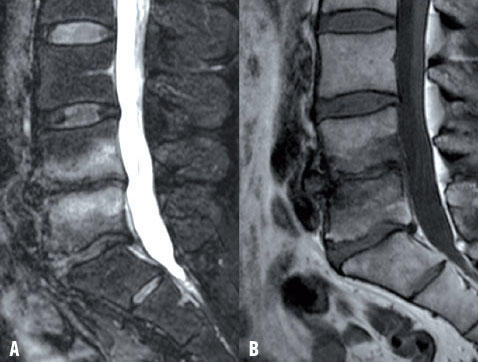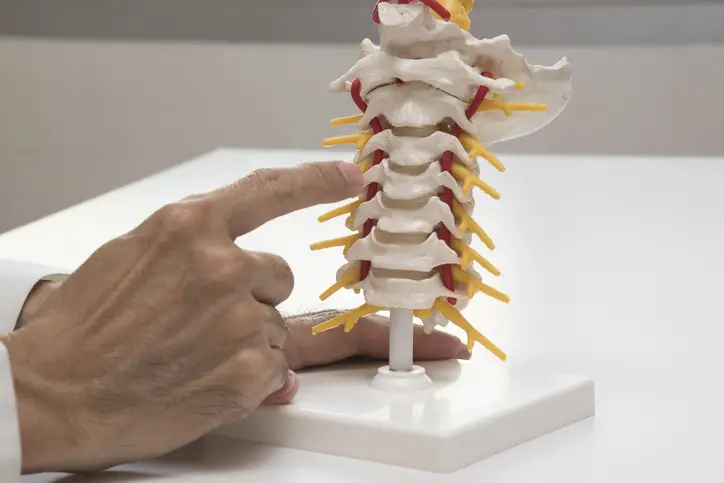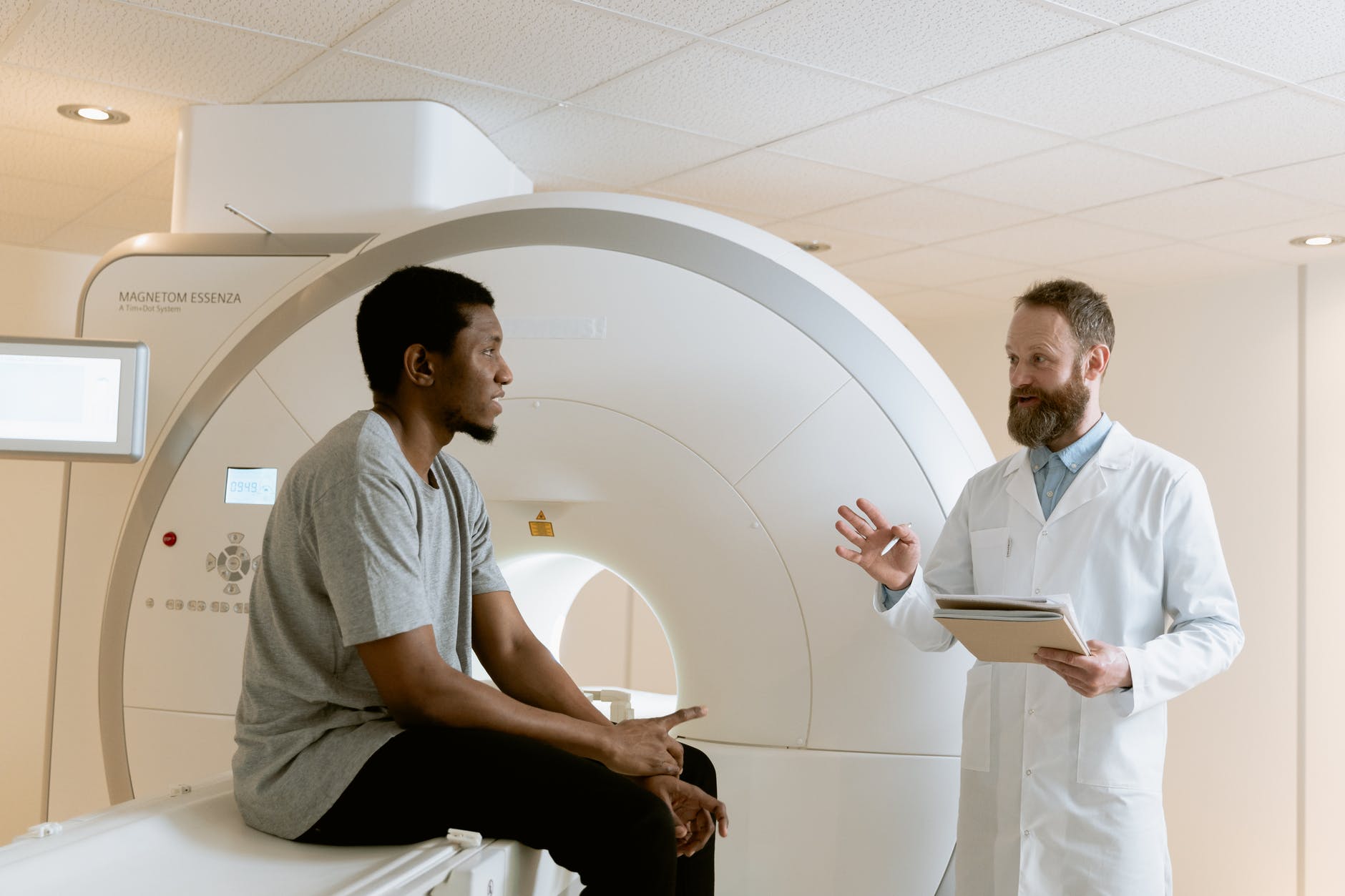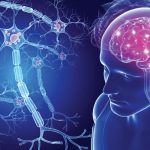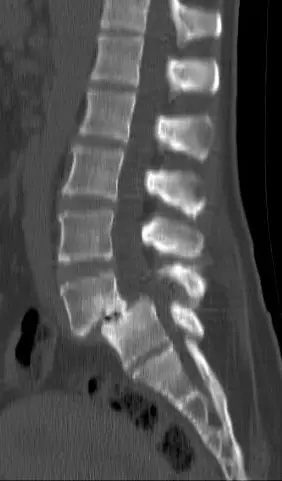A change Modic corresponds to an abnormal and pathological appearance of vertebrae withIRM (the'imagery by magnetic resonance), in other words, it is a lesion spinal vertebral seen on MRI.
Modic changes mainly affect the lumbar region, they usually occur between the ages of 25 and 40.
These lesions bone are named after Dr. Michael Modic, who classified them into 3 types: modic 1, 2 and 3. Modic 1 is the most important of the modic changes, it is the one that we will deal with in this article.
Symptoms and pain that accompany modic signal 1 and other modic signals can be disabling and impose restrictions on work or even permanent cessation of work. In some cases, the profession itself exposes to the risk of modic changes, we then speak of professional diseases. Modic 1 and invalidity : we will discover everything in the rest of the article.
Definition
Modic 1
Le modic change 1 is when the vertebrate appears in hypersignal in T2 and in hyposignal in T1, i.e. its gray will be lighter in T2 and darker in T1, compared to the gray of the surrounding tissues, knowing that T1 and T2 are two images of different contrast obtained by MRI.
When the vertebra appears this way, it means that its structure has undergone changes and that there is edema or inflammation at its level.
People who have modic changes usually suffer from lower back pain, it is strongly believed that there is a relationship between these two, indeed the modic change is probably related to a disc disease, which may be the cause of back pain and low back pain.
Causes and clinical presentation
The causes of modic 1
We are not entirely certain of the causes of the modic changes, the researchers are currently doing extensive studies in order to be able to give an explanation for these radiological lesions, but as already mentioned above, the latter seem to be caused by a disc pathology.
Two theories have been given regarding the origin of the disc disease : a degenerative origin and an infectious origin.
Degenerative disc disease
In medicine, the degeneration is the loss of a tissue, a degenerative disc disease is thus a lesion where the cartilaginous tissue of the intervertebral discs. Several factors can cause cartilage degeneration disk, we cite as an example the aging and physical activity intense.
Degenerative disc disease is a cause mechanical of modic change 1, thewear du intervertebral disc favors small broken bones and the micro-trauma du vertebra body, leading to lesions inflammatory and oedemas.
infectious disc disease
Infectious disc disease is theinfiltration intervertebral discs by anaerobic bacteria, they cause an infection that is not very virulent and benign, but which develops slowly and gives modic signals on the MRI.
The clinical presentation of modic 1
As with other modic signals, back pain and low back pain generally accompany modic change 1. These pains are:
- intense, even disabling;
- constant and continuous;
- with nocturnal exacerbation;
- rebels to analgesics and medical treatment.
However, it is important to know that not all modic changes cause symptoms: some patients are completely and perfectly asymptomatic.
Can we work with modic changes?
As mentioned previously, the intensity of the symptoms that accompany the modic changes is very variable, there are asymptomatic patients, patients with moderate pain and cases where we find a disability and a disability important.
The healthcare professional proposes a decision regarding labor, based on the patient's symptoms and prognosis, as well as the importance of the gene that these cause.
It may require a simple break of a few days and sessions of re-education as well as physiotherapy if the pain is acute and responsive to treatment. If, on the contrary, it is chronic and persistent (chronic low back pain), restrictions can be proposed, so that the patient continues to work without any risk to his health.
For example, we can limit the time of the sitting of the patient, as well as all postures likely to accentuate the pain, offer him an ergonomic seat to keep him comfortable, prohibit him from raise heavy loads or limit the weight of the loads it can carry, etc.
If there is a disability and impairment functional important, the doctor can unfortunately ask for the definitive cessation of work.
Modic 1, recognized as an occupational disease?
What is occupational disease?
An occupational disease is a disease caused by the conditions of the patient's occupation.. It can, for example, occur after direct exposure to substances harmful to health, or result from certain physical conditions, such as carrying heavy loads.
All occupational diseases are mentioned in the tables of the general and agricultural social security system.
Modic 1 and disability: when is modic 1 recognized as an occupational disease?
For modic 1 change to be recognized as an occupational disease, it must meet the following criteria:
- he must be linked to a herniated disc cause of a sciatica or an radiculalgia cruel ;
- The patient must have a job where he carries heavy loads, or a job thatexposes to vibrations that can be transmitted to the whole body, such as driving heavy vehicles;
- the sciatica must result from a herniation between the L4 and L5, or L5 and S1 vertebrae, as for crural radiculalgia, it must result a hernia between the L2 and L3, L3 and L4 or L4 and L5 vertebrae ;
- the duration of the pain must be more than 3 months (Chronic Pain);
- the existence of proof radiological hernia;
- the duration of exposure to the risk must be at least 5 years (the patient has been practicing his profession for at least 5 years), knowing that an exposure period of 5 years corresponds to treatment for 6 months.
Modic 1 and disability: conclusion (treatment and solutions)
Several therapeutic methods are used to ease the pain and limit themodic 1 disability and to the other modic signals, we note the rest, the medical treatment, physiotherapy, le lumbar corset, etc. the surgical treatment (surgical intervention) can also be proposed, we are talking about the neurosurgery and surgery orthopedic aimed at correcting conditions with a severe prognosis.



